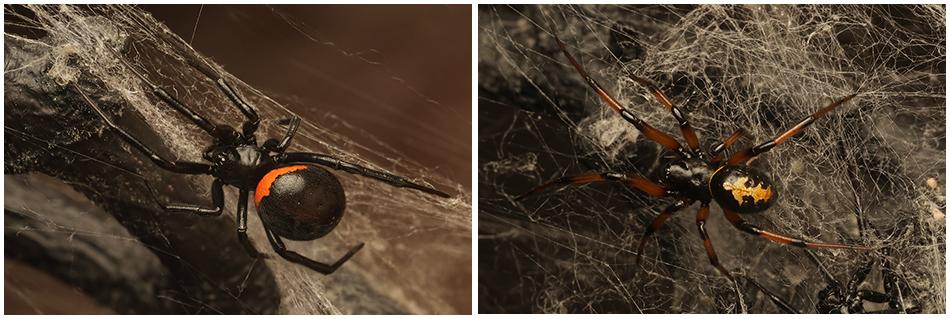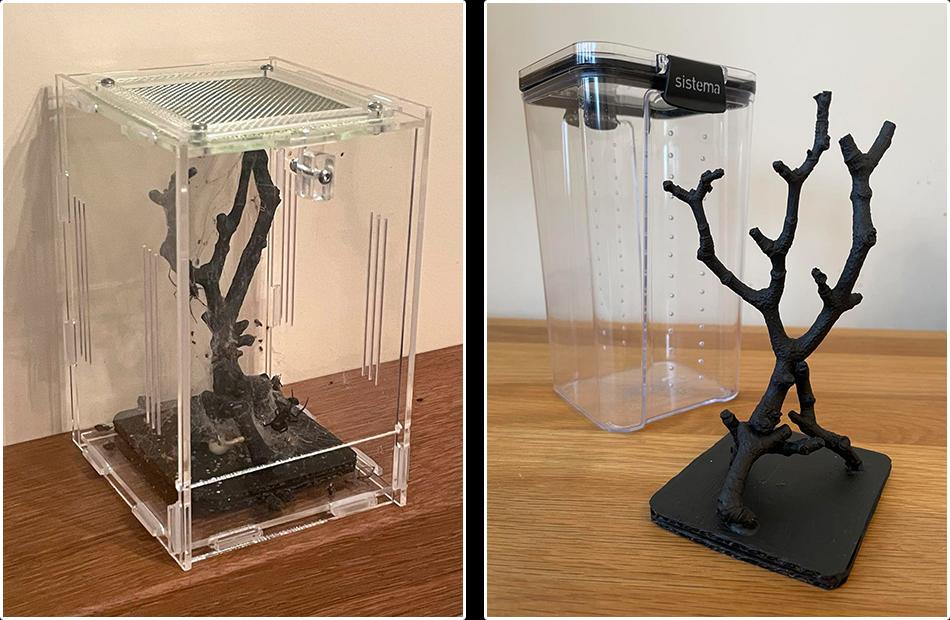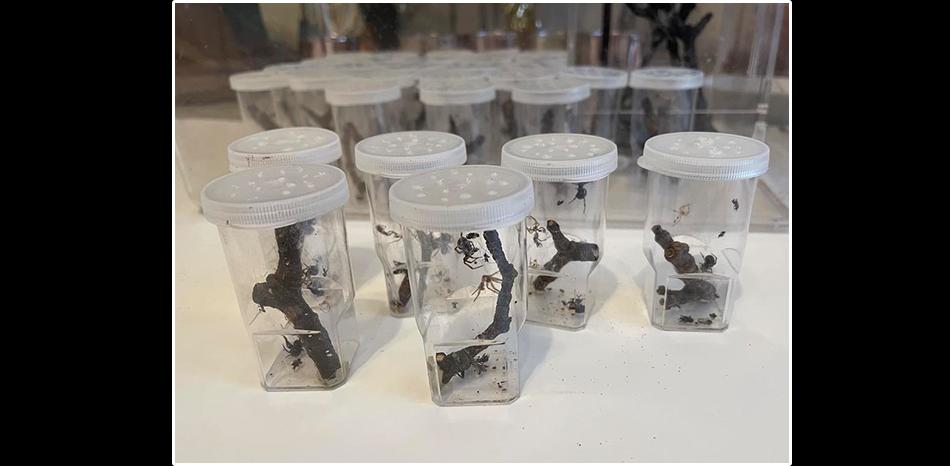
Adult female on the left and adult male on the right.
BINOMINAL NAME: Steatoda paykulliana
COUNTRY OF ORIGIN: Most countries in the Mediterranean region.
LIFE-SPAN: Usually 1-3 years. Occasionally up to 5 years.
DIFFICULTY IN KEEPING: Easy and ideal for beginners.
COMMUNIAL SPECIES: No.
HEAT
Steatoda Paykulliana have become increasingly popular in the exotic pet trade in recent years. With their beautiful colours and their striking appearance it's easy to see why people are attracted to keeping these fascinating spiders. Like other Steatoda species Steatoda Paykulliana are very easy to keep and require very little maintenance. Despite being a Mediterranean species Steatoda Paykulliana requires no additional heating and is happily kept at room temperature in a heated house. In my own house this means being kept at around 17-19 degrees during the winter months when the central heating is on. Steatoda Paykulliana can survive pretty cold temperatures during the winter months in their native countries but in captivity if the temperature drops below around 10 degrees the spiders can become quite lethargic and may stop feeding. As long as their enclosure has sufficient ventilation, and the spiders are not placed in a position where they are unable to escape from direct sunlight during the summer months, then you don't have to worry too much about Steatoda Paykulliana over-heating either.
HUMIDITY
Steatoda Paykulliana do not like excessively humid environments and in the wild they are usually found in dry, arid areas. Steatoda Paykulliana receive nearly all the moisture they need when feeding from their prey and don't often need to drink water. In particularly hot weather it may help to give the enclosure a very light misting of water once every 3-4 weeks. This usually isn't necessary at all but may occasionally be useful if the spider is going through a period of fasting.
FEEDING
Steatoda Paykulliana are opportunist feeders and will feed on most small invertebrates. In the wild may be forced to go several weeks in between their meals. in captivity some specimens will eat as often as food is placed in front of them because in the wild they never know when their next meal is coming. It is possible to over-feed these spiders and doing so will shorten the life of the spider. The abdomen can also become excessively swollen with over-feeding, to the point where the abdomen starts to split away from the cephalothorax.
Steatoda Paykulliana require feeding with a live invertebrate, close in size to their own body-weight, about once every 10 days. If smaller prey is used then the spider may require two specimens. With juvenile Steatoda Paykulliana I usually feed them once every 7 days. Live prey is preferred but some specimens will also feed on dead invertebrates placed in their web. From my own experience Steatoda Paykulliana will feed on crickets, flies, gnats & mosquitoes, mealworms, moths, beetles and woodlice. During the warmer months of the year my Steatoda Paykulliana are fed almost entirely on various species of fly that enter my house. Any gnats and mosquitoes that enter my house are always fed to the spiders. During the colder months, when flies aren't so easily found, I feed the Steatoda Paykulliana with small crickets purchased from my local reptile shop. Despite the size of the Steatoda Paykulliana I have found that they avoid larger crickets though. This is probably because of the powerful hind legs of larger crickets, and the damage these legs can do if the cricket kicks out at the approaching spider. It is not uncommon for Steatoda Paykulliana to go through periods of fasting when they lose all interest in food. Do not worry if your spider isn't interested in feeding for a while. Continue offering the spider food once a week. If the spider still shows no interest in its prey by the end of the day then the prey should be removed and offered again in another weeks time. Steatoda Paykulliana can survive for several weeks without eating so do not be alarmed if your spider still refuses its meal. I have had specimens refuse food for over a month before finally regaining their appetite. This is particularly common when the spider is due to moult.
ENCLOSURE
Steatoda Paykulliana are Cob-web Spiders, or Tangle-web Spiders, and adult specimens require space to build their webs. The ideal size of the vertical enclosure for an adult specimen is around 10cm x 10cm x 15cm. Slightly smaller enclosures can be used but these may not give the spider sufficient room to build a decent sized web. Slightly larger enclosures can be used but with larger enclosures it can be very difficult for the spiders to catch their prey. It is important to ensure the enclosure has sufficient ventilation coming from at least 2 or 3 faces.
The enclosure should contain dried twigs for the spider to build its web on. With my own Steatoda Paykulliana enclosures I cut a piece of thick card, to just under the size of the base of the enclosure. I then use a hot-glue gun to construct a twig structure and glue this to the cardboard base. This allows the entire web and spider to be removed from the enclosure for photography purposes if required. Once constructed I paint the base and the twigs with very dark brown, almost black, paint.
Juveniles up to around 4-5mm in body-length can happily be kept in small spiderling pots of around 5.5cm in height, and with a diameter of around 3cm. Again, these small pots make it much easier for the young spiders to catch their food. An example of the ideal spiderling pots can be seen here. The pots should also contain 1 or 2 small twigs, glued to the base, for the spider build its web on. The lid should be perforated with plenty of tiny holes to allow airflow. The enclosures do not require any substrate or plants to be used. Adding substrate or plants to the enclosure will introduce unwanted moisture and will raise humidity levels beyond the tolerance levels of this species.

I use both of these types of enclosures for my adult Steatoda paykulliana. On the left is a purpose designed invertebrate enclosure. It comes in kit form and has to be assembled prior to use. This enclosure features an opening front panel and a mesh top panel. There is excellent ventilation on all sides and the gaps are small enough to prevent even the tiniest of Steatoda spiderlings from escaping. These enclosures can be bought from Internetreptile.com.
On the right is a food storage container with a removeable lid. The removeable lid allows the twig structure to easily be removed. This enclosure is air-tight and requires the drilling of tiny holes don the length of both sides to provide adequate ventilation. It's very difficult to drill holes small enough to prevent the escape of young spiderlings so this type of enclosure is not suitable for hatching egg-sacs in. These Sistema food containers can be bought from Amazon.co.uk.

small pots for spiderlings up to 4-5mm in length.
CAN STEATODA PAYKULLIANA BE KEPT COMMUNALLY?
No Steatoda paykulliana must be kept singularly. Keeping more than one specimen in an enclosure together will eventually result in cannibalism and one of the spiders will eat the other. Cannibalism occurs regularly between spiderlings from an early age. An adult male can usually be kept with a mature, or nearly mature, female specimen. Sometimes the female will still eat the male though and this can happen before or after copulation has taken place.
HANDLING
Can Steatoda paykulliana be safely handled? No, this species should not be handled. As with established species of False Widow in the UK the bites from Steatoda paykulliana can be rather unpleasant, although most arachnologists do not consider the venom to be medically significant to humans. It is far safer for both the spider and for yourself if these spiders are not handled. If they need to be moved then I use a small, soft paintbrush and gently encourage the spider into a small temporary pot.
SOURCING YOUR STEATODA PAYKULLIANA
Please help protect this species, and other invertebrates, by always checking with any sellers that they are only selling captive-bred specimens and not wild-caught spiders. Taking specimens from the wild can have a very damaging effect on the local populations of species in countries where they are native. Legitimate sellers will always be happy to confirm that the specimens they are selling are captive-bred.
BUYING STEATODA PAYKULLIANA FROM JASON STEEL
I have been studying and breeding Steatoda paykulliana in captivity now for several years. This is the only species that I breed. All my original founding stock were individual specimens that arrived in the UK as accidental stowaways hidden amidst imported fruit. Please email me to check current availability, or to check when the next batch of spiderlings will be available.